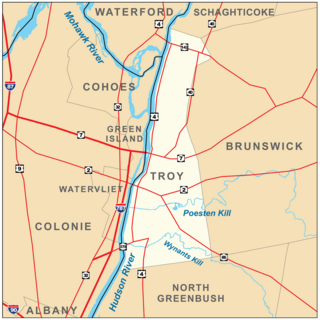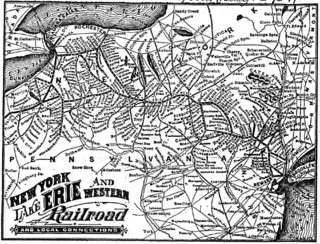
The Erie Railroad was a railroad that operated in the northeastern United States, originally connecting New York City — more specifically Jersey City, New Jersey, where Erie's former terminal, long demolished, used to stand — with Lake Erie. It expanded west to Chicago with its 1941 merger with the former Atlantic and Great Western Railroad, also known as the New York, Pennsylvania and Ohio Railroad. Its mainline route proved influential in the development and economic growth of the Southern Tier, including cities such as Binghamton, Elmira, and Hornell. The Erie Railroad repair shops were located in Hornell, and were Hornell's largest employer. Hornell was also where Erie's main line split into two routes, one north to Buffalo and the other west to Cleveland.

The Delaware, Lackawanna & Western Railroad was a U.S. Class 1 railroad that connected Buffalo, New York, and Hoboken, New Jersey, a distance of about 400 miles (640 km). Incorporated in 1853, the DL&W was profitable during the first two decades of the twentieth century, but its margins were gradually hurt by declining traffic in coal and competition from trucks. In 1960, the DL&W merged with rival Erie Railroad to form the Erie Lackawanna Railroad.

The Erie Lackawanna Railway, known as the Erie Lackawanna Railroad until 1968, was formed from the 1960 merger of the Erie Railroad and the Delaware, Lackawanna & Western Railroad. The official motto of the line was "The Friendly Service Route".
The Morris and Essex Railroad was a railroad across northern New Jersey, later part of the main line of the Delaware, Lackawanna and Western Railroad.
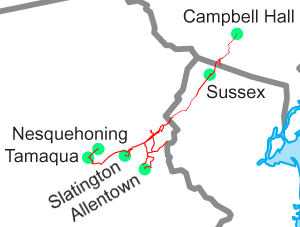
The Lehigh & New England Railroad was a Class I railroad located in Northeastern United States that acted as a bridge line. It was the second notable U.S. railroad to file for abandonment in its entirety, the first being the New York, Ontario & Western Railway.

The Delaware–Lackawanna Railroad is a shortline railroad operating in Northeastern Pennsylvania, especially the Scranton area.
The Belvidere Delaware Railroad was a railroad running along the eastern shore of the Delaware River from Trenton, New Jersey north via Phillipsburg, New Jersey to the small village of Manunka Chunk, New Jersey. It became an important feeder line for the Lehigh Valley Railroad's join to the Central Railroad of New Jersey, which was constructed into Phillipsburg, NJ at about the same time. This connected Philadelphia and Trenton, NJ at one end of the shortline railroad to the rapidly growing lower Wyoming Valley region, and via the Morris Canal or the CNJ, a slow or fast connection to New York City ferries crossing New York Harbor from Jersey City, NJ. In 1871 the CNJ leased various railroads in Pennsylvania, most from the Lehigh Coal & Navigation Company allowing the CNJ to penetrate to the upper Wyoming Valley, over some stretches, competing directly with the Lehigh Valley Railroad and with the Lehigh Canal and the trunk road connection of the Belvidere Delaware Railroad to New York became less profitable since Philadelphia connected more easily to Northeastern Pennsylvania thereafter without needing a double-crossing of the Delaware River; a general revenue decline ensued, leading to the Pennsylvania Railroad acquiring the rights, where it served as part of the Pennsylvania Railroad (PRR) system, carrying mainly anthracite coal and iron ore from northeastern Pennsylvania to population centers along the coast.

The Wilmington and Western Railroad is a freight and heritage railroad in northern Delaware, operating over a former Baltimore and Ohio Railroad (B&O) branch between Wilmington and Hockessin. The 10.2-mile (16.4 km) railroad operates both steam and diesel locomotives. It was added to the National Register of Historic Places as a national historic district in 1980. Wilmington & Western serves one customer for revenue service, and interchanges with CSX Transportation at Landenberg Junction, Delaware
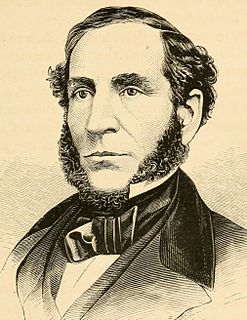
George Whitfield Scranton was an industrialist and politician, a Republican member of the U.S. House of Representatives from Pennsylvania from March 4, 1859, until his death in 1861. Moving to Pennsylvania in the late 1830s to establish an iron furnace, he and his brother Selden T. Scranton are considered among the founders of the city of Scranton, Pennsylvania, named for their family. They and two partners established what became known as the Iron & Coal Company. They developed a method of producing T-rails for constructing railroad track, which previously had been imported from England. The innovation led to a boom in production of track and construction of railroads.

Hackettstown is a New Jersey Transit station in Hackettstown, New Jersey. The station is located at the intersection of Valentine Street and Beatty Street and is the western terminus of the Morristown Line and the Montclair-Boonton Line, which both provide service to Hoboken Terminal or to Pennsylvania Station in Midtown Manhattan via Midtown Direct. Hackettstown station is the only active New Jersey Transit station in Warren County. The line from Hackettstown – Dover is diesel powered, requiring a transfer at Dover, Montclair State University or Newark Broad Street to an electrified train to New York Penn Station. Proposals exist of an extension of the Montclair-Boonton Line, including an extension to Washington and possibly Phillipsburg further along the Washington Secondary.

The Paulinskill Viaduct, also known as the Hainesburg Viaduct, is a reinforced concrete railroad bridge that crosses the Paulins Kill in Knowlton Township, New Jersey. When completed in 1910, it was the largest reinforced concrete structure in the world.

Moses Taylor was a 19th-century New York merchant and banker and one of the wealthiest men of that century. At his death, his estate was reported to be worth $70 million, or about $1.8 billion in today's dollars. He controlled the National City Bank of New York, the Delaware, Lackawanna & Western railroad, the Moses Taylor & Co. import business, and he held numerous other investments in railroads and industry.

Upper Hack Lift is a lift bridge carrying the New Jersey Transit Main Line across the Hackensack River at mile 6.9 between Secaucus, New Jersey and Lyndhurst.
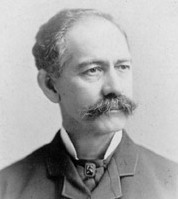
John Griffith McCullough was an American businessperson and attorney. He was Attorney General of California during the Civil War, and the 49th Governor of Vermont from 1902 to 1904.
The Lackawanna Steel Company was an American steel manufacturing company that existed as an independent company from 1840 to 1922, and as a subsidiary of the Bethlehem Steel company from 1922 to 1983. Founded by the Scranton family, it was once the second-largest steel company in the world. Scranton, Pennsylvania developed around the company's original location. When the company moved to a suburb of Buffalo, New York, in 1902, it stimulated the founding of the city of Lackawanna.

Percy Rivington Pyne II was a banker, financier, and philanthropist.
H.B. Claflin & Company was a Manhattan-based dry goods business which was incorporated in 1890. The company acted as wholesalers who were middlemen between manufacturers and retailers of dry goods. The corporation became insolvent in June 1914, with a debt of $34,000,000. Judge Learned Hand of the United States District Court in New York appointed receivers for the firm on June 25, 1914. The trade of the wholesaler was negatively affected by the migration of the dry goods industry to uptown Manhattan and a failure to adapt to the changing business landscape.
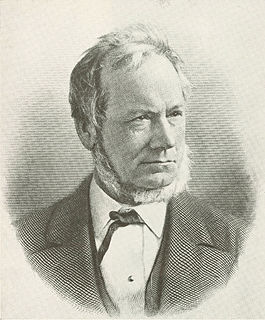
Samuel Sloan was an American politician, businessman and executive. He is most known for his tenure as the president of the Delaware, Lackawanna & Western Railroad (DL&W) for 32 years.

Frank J. Nies was an American architect. He is best known for having designed numerous Delaware, Lackawanna & Western Railroad stations, at least fifteen of which have been listed on the U.S. National Register of Historic Places : He sometimes worked with the railroad's chief engineer, Lincoln Bush. Before working for the Delaware, Lackawanna & Western, Nies was a partner in the architectural firm Finkler & Nies, with Adolph Finkler, in Chicago in 1896.
The Cayuga and Susquehanna Railroad was a railroad in the state of New York, in the United States. Its line ran from Ithaca, New York to Owego, New York. It was founded in 1829 and began operations in 1834. The Delaware, Lackawanna and Western Railroad (Lackawanna) leased the company in 1855 but it remained in existence as a non-operating subsidiary. It was conveyed to Conrail on the bankruptcy of the Erie Lackawanna Railway, successor to the Lackawanna, in 1976.






